Lecanora polytropopsis Cl. Roux, M. Bertrand & Poumarat
in Roux & al., Bull. Soc. linn. Provence, 73: 97, 2022
Synonyms:
Distribution:
Description: Thallus crustose, episubstratic, pale brownish yellow, somehow glossy, areolate-subsquamulose, forming 0.4-5.5 cm wide patches, without a prothallus, the areoles subsquamulose, dispersed to crowded, lobulate (the lobules c. 0.1-0.55 mm), glebulose, orbicular to oval, of variable sizes, 1.8-10 mm wide, 0.1-1.3 mm thick, flat to slightly convex, smooth, the lower surface often substipitate, developing on a greenish black hypothallus. Cortex colourless to pale yellow, 40-70 μm thick, with a poorly distinct, 3-4 μm thick epinecral layer containing both small and larger crystals, overlaying a 42-67 μm thick, paraplectenchymatous layer of mainly anticlinally arranged hyphae with small yellowish crystals and larger colourless crystals which are partly soluble in N and in K, the lower part devoid of, or poor in crystals; algal layer continuous; medulla up to 1 mm thick, dense, with a few large, colourless crystals insoluble in both N and K. Apothecia lecanorine, (0.3-)0.4-0.9(-1.1) mm across, adnate or subsessile, with a pale brownish yellow, slightly concave to slightly convex disc and a 0.05-0.1 mm thick, often wavy, sometimes finally excluded thalline margin (the apothecia then appearing biatorine). Thalline exciple 65-90 μm thick, ecorticate, often without algae, an algal layer being present only below the hypothecium, entirely prosoplectenchymatous, the hyphae with a fan-like arrangement broadening towards the base, with crystals; proper exciple colourless, 75-130 μm thick, the hyphae with a fan-like arrangement broadening towards the apex, the upper part paraplectenchymatous, with numerous, small, yellowish crystals insoluble in N and soluble in K; the lower part prosoplectenchymatous, with similar small crystals plus larger, colourless crystals soluble in N; epithecium yellowish brown, 15-20 μm thick, with small yellowish granules insoluble in N and soluble in K; hymenium colourless, 50-80 μm high, devoid of crystals in lower part, I+ blue; paraphyses coherent, simple or sparingly branched and anastomosing, 1.5-2 μm thick at base, the apical cells 2-4 μm wide; subhymenium colourless, 22-35 μm high, without crystals; hypothecium colourless, 25-60 μm high, I-. Asci 8-spored, clavate, Lecanora-type. Ascospores 1-celled, hyaline, ellipsoid to broadly ellipsoid, (7.5-)8.5-11(-12) x (5.5-)6-7.5(-8.5) μm, thin-walled. Pycnidia unknown. Photobiont chlorococcoid, the cells up to 9 μm wide. Spot tests: K+ pale yellow, C-, KC+ pale yellow, P-. Chemistry: usnic acid. Note: a recently-described, silicicolous species growing on horizontal to vertical surfaces in the alpine and subalpine belts. Known from the Pyrenees and the French Alps; to be looked for in Italy. The description is based on Roux & al. (2022).
Growth form: Crustose
Substrata: rocks
Photobiont: green algae other than Trentepohlia
Reproductive strategy: mainly sexual

Predictive model
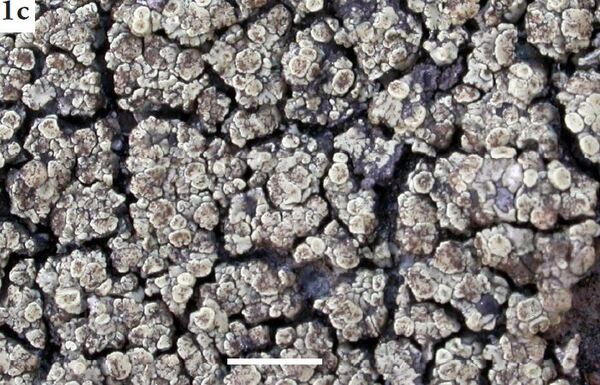
Source: Roux C., Bertrand M., Poumarat S., Uriac P. 2022. Quelques espèces nouvelles saxicoles – calcifuges de Lecanora du groupe polytropa (Ascomycota, Lecanoraceae) découvertes en France. Bull. Soc. linn. Provence, 73: 79-120.
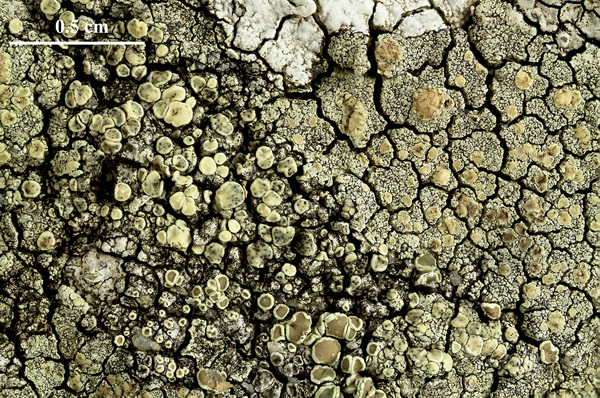
Felix Schumm - CC BY-SA 4.0
[19695], Schweiz, Splügenpass, 46.505244° N, 9.330480° E, 2122 m. Leg. A. Matuschewski Sept. 2017, det. F. Schumm.
As L. polytropa

Felix Schumm - CC BY-SA 4.0
[19695], Schweiz, Splügenpass, 46.505244° N, 9.330480° E, 2122 m. Leg. A. Matuschewski Sept. 2017, det. F. Schumm.
As L. polytropa

Felix Schumm - CC BY-SA 4.0
[19695], Schweiz, Splügenpass, 46.505244° N, 9.330480° E, 2122 m. Leg. A. Matuschewski Sept. 2017, det. F. Schumm.
As L. polytropa
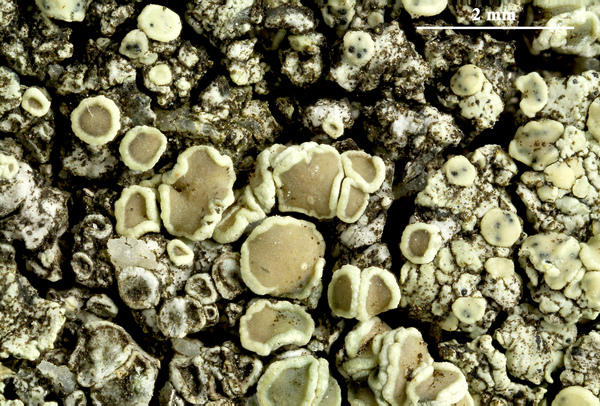
Felix Schumm - CC BY-SA 4.0
[19695], Schweiz, Splügenpass, 46.505244° N, 9.330480° E, 2122 m. Leg. A. Matuschewski Sept. 2017, det. F. Schumm.
As L. polytropa

Felix Schumm - CC BY-SA 4.0
[19695], Schweiz, Splügenpass, 46.505244° N, 9.330480° E, 2122 m. Leg. A. Matuschewski Sept. 2017, det. F. Schumm.
As L. polytropa
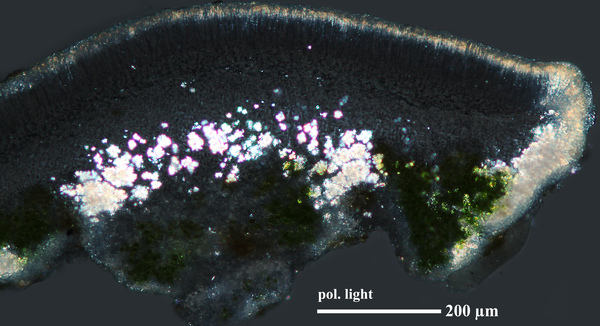
Felix Schumm - CC BY-SA 4.0
[19695], Schweiz, Splügenpass, 46.505244° N, 9.330480° E, 2122 m. Leg. A. Matuschewski Sept. 2017, det. F. Schumm.
As L. polytropa

Felix Schumm - CC BY-SA 4.0
[19695], Schweiz, Splügenpass, 46.505244° N, 9.330480° E, 2122 m. Leg. A. Matuschewski Sept. 2017, det. F. Schumm.
As L. polytropa

Felix Schumm - CC BY-SA 4.0
[19695], Schweiz, Splügenpass, 46.505244° N, 9.330480° E, 2122 m. Leg. A. Matuschewski Sept. 2017, det. F. Schumm.
As L. polytropa

Felix Schumm - CC BY-SA 4.0
[19695], Schweiz, Splügenpass, 46.505244° N, 9.330480° E, 2122 m. Leg. A. Matuschewski Sept. 2017, det. F. Schumm.
As L. polytropa
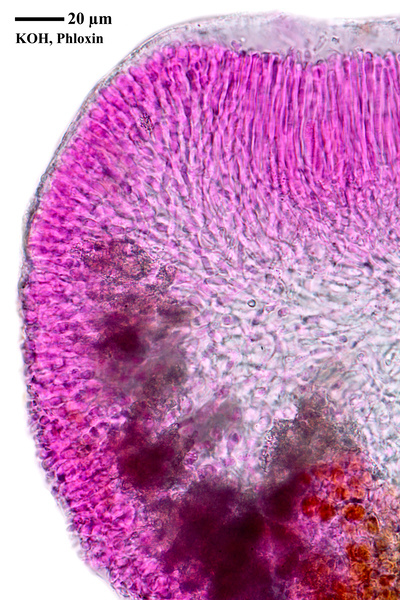
Felix Schumm - CC BY-SA 4.0
[19695], Schweiz, Splügenpass, 46.505244° N, 9.330480° E, 2122 m. Leg. A. Matuschewski Sept. 2017, det. F. Schumm.
As L. polytropa

Felix Schumm - CC BY-SA 4.0
[19695], Schweiz, Splügenpass, 46.505244° N, 9.330480° E, 2122 m. Leg. A. Matuschewski Sept. 2017, det. F. Schumm.
As L. polytropa

Felix Schumm - CC BY-SA 4.0
[19695], Schweiz, Splügenpass, 46.505244° N, 9.330480° E, 2122 m. Leg. A. Matuschewski Sept. 2017, det. F. Schumm.
As L. polytropa
Growth form: Crustose
Substrata: rocks
Photobiont: green algae other than Trentepohlia
Reproductive strategy: mainly sexual

Predictive model

Source: Roux C., Bertrand M., Poumarat S., Uriac P. 2022. Quelques espèces nouvelles saxicoles – calcifuges de Lecanora du groupe polytropa (Ascomycota, Lecanoraceae) découvertes en France. Bull. Soc. linn. Provence, 73: 79-120.

Felix Schumm - CC BY-SA 4.0
[19695], Schweiz, Splügenpass, 46.505244° N, 9.330480° E, 2122 m. Leg. A. Matuschewski Sept. 2017, det. F. Schumm.
As L. polytropa

Felix Schumm - CC BY-SA 4.0
[19695], Schweiz, Splügenpass, 46.505244° N, 9.330480° E, 2122 m. Leg. A. Matuschewski Sept. 2017, det. F. Schumm.
As L. polytropa

Felix Schumm - CC BY-SA 4.0
[19695], Schweiz, Splügenpass, 46.505244° N, 9.330480° E, 2122 m. Leg. A. Matuschewski Sept. 2017, det. F. Schumm.
As L. polytropa

Felix Schumm - CC BY-SA 4.0
[19695], Schweiz, Splügenpass, 46.505244° N, 9.330480° E, 2122 m. Leg. A. Matuschewski Sept. 2017, det. F. Schumm.
As L. polytropa

Felix Schumm - CC BY-SA 4.0
[19695], Schweiz, Splügenpass, 46.505244° N, 9.330480° E, 2122 m. Leg. A. Matuschewski Sept. 2017, det. F. Schumm.
As L. polytropa

Felix Schumm - CC BY-SA 4.0
[19695], Schweiz, Splügenpass, 46.505244° N, 9.330480° E, 2122 m. Leg. A. Matuschewski Sept. 2017, det. F. Schumm.
As L. polytropa

Felix Schumm - CC BY-SA 4.0
[19695], Schweiz, Splügenpass, 46.505244° N, 9.330480° E, 2122 m. Leg. A. Matuschewski Sept. 2017, det. F. Schumm.
As L. polytropa

Felix Schumm - CC BY-SA 4.0
[19695], Schweiz, Splügenpass, 46.505244° N, 9.330480° E, 2122 m. Leg. A. Matuschewski Sept. 2017, det. F. Schumm.
As L. polytropa

Felix Schumm - CC BY-SA 4.0
[19695], Schweiz, Splügenpass, 46.505244° N, 9.330480° E, 2122 m. Leg. A. Matuschewski Sept. 2017, det. F. Schumm.
As L. polytropa

Felix Schumm - CC BY-SA 4.0
[19695], Schweiz, Splügenpass, 46.505244° N, 9.330480° E, 2122 m. Leg. A. Matuschewski Sept. 2017, det. F. Schumm.
As L. polytropa

Felix Schumm - CC BY-SA 4.0
[19695], Schweiz, Splügenpass, 46.505244° N, 9.330480° E, 2122 m. Leg. A. Matuschewski Sept. 2017, det. F. Schumm.
As L. polytropa

 INDEX FUNGORUM
INDEX FUNGORUM
 GBIF
GBIF



